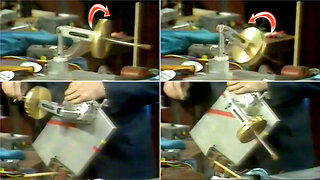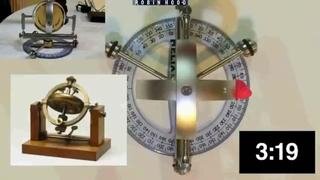🔬#MESExperiments 14: Angle of Gyroscope Has Little Effect on Rate/Period of Precession
In #MESExperiments 14, I demonstrate a very interesting finding that I had not previously suspected with gyroscopes and that is the steepness of the angle of precession has very little direct effect on the rate of precession. Note that in this context I refer to the rate or “period” of precession as the number of precession revolutions per time (in this case per minute hence RPM) and should be distinguished from precessional or angular velocity which is the actual speed of the center of mass moving in precession. This observation of the precession rate being unaffected by the steepness of the angle indicates both that the angular velocity of the center of mass is increasing as the angle is steeper (since the gyro has further distance to precess) but also that there is an underlying symmetry taking place between the gyro spin speed and the rate of precession.
Furthermore, my prior intuition was that the steeper the gyroscope the more “torque” would be imposed which should drive both the precession rate and velocity faster to maintain its (anti-gravitic) levitation. But given my earlier experiments of gyroscopes literally behaving massless in precession, it seems fitting and more reasonable that precession has a much more correlated and direct connection to the spin speed than conventionally understood.
Four gyroscope tests were performed in this experiment and at angles: 31°, 45°, 65°, and 84° from the vertical. The full results are show in the Excel Spreadsheet file and corresponding Steemit Notes.
- Excel File: https://1drv.ms/x/s!As32ynv0LoaIh_F1zEvJGUMvdW_6zw?e=B3X619
- Hive Notes: https://peakd.com/mesexperiments/@mes/mesexperiments-14-angle-of-gyroscope-has-little-effect-on-rate-period-of-precession-interesting
I discuss the data and findings in the Steemit article so make sure to go over it. Interesting findings include the precession rate increases with elapsed time but up to a “peak precession rate” after which the precession rate drops. Since the near horizontal 84° gyro fell down quickly it did not exhibit a typical “peak precession rate” but rather fell at its highest precession rate. This is definitely a subject of further study.
Further discussion of the findings, the links to the original gyro tests, specific data measurements, and weight measurements (the gyro used is 150.68 grams with the stem) are also included in the Steemit post.
Note: I accidentally skipped over the 233 revolutions count for the 65° test but have corrected this in the Excel/Steemit data.
Stay Tuned for #MESExperiments 15…
Related Videos:
#MESExperiments video series: https://peakd.com/experiments/@mes/list
DRAFT #MESExperiments video series: https://mes.fm/experiments-draft
#MESScience video series: https://mes.fm/science-playlist
#AntiGravity video series: https://peakd.com/antigravity/@mes/series
#FreeEnergy video series: https://mes.fm/freeenergy-playlist .
------------------------------------------------------
SUBSCRIBE via EMAIL: https://mes.fm/subscribe
DONATE! ʕ •ᴥ•ʔ https://mes.fm/donate
Like, Subscribe, Favorite, and Comment Below!
Follow us on:
MES Truth: https://mes.fm/truth
Official Website: https://MES.fm
Hive: https://peakd.com/@mes
MORE Links: https://linktr.ee/matheasy
Email me: contact@mes.fm
Free Calculators: https://mes.fm/calculators
BMI Calculator: https://bmicalculator.mes.fm
Grade Calculator: https://gradecalculator.mes.fm
Mortgage Calculator: https://mortgagecalculator.mes.fm
Percentage Calculator: https://percentagecalculator.mes.fm
Free Online Tools: https://mes.fm/tools
iPhone and Android Apps: https://mes.fm/mobile-apps
-
 8:41
8:41
Math Easy Solutions
1 year ago🔬#MESExperiments 15: Gyroscopes Tend to Rise Until Precession Rate Has Peaked #Interesting
971 -
 2:16
2:16
Math Easy Solutions
1 year ago $0.01 earned🔬#MESExperiments 4: Gyroscopes Precess with Zero ‘Angular Momentum’
1381 -
 27:23
27:23
JessieJohn
1 year agoGYROSCOPES: Principles of Gyroscopes. Why They Behave As they Do.
15 -
 2:14
2:14
wendellpayne
1 year agoRing Laser Gyroscope Experiment Proves Earth's Rotation - 15deg/hour
355 -
 10:42
10:42
Preston Flatt
1 year agoPretty Cool Exercise Generating Gyroscope: The New Posture Generator In A Ball.
19 -
 25:29
25:29
Anti-Disinfo League
1 year agoGYROSCOPES AND RIGIDITY TO SPACE
88 -
 17:59
17:59
RobinsHoodlum
1 year agoTesting The Globe Earth - Mechanical Gyroscopes
9943 -
 23:29
23:29
FlatEarthArchive
1 year agoMPU-6050 Gyroscope Experiment (Flat Earth)
180 -
 11:01
11:01
Physics - Classical Mechanics - DrOfEng
2 years agoExample problem 36 - Rotational kinematics - Classical mechanics - Physics
18 -
 3:10
3:10
MagneticPropulsion
1 year agoTorqueless Gyroscope Motor
16